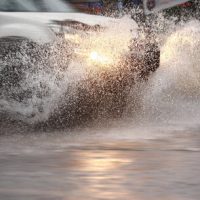The Dangers of Hydroplaning

It is no secret that snow storms make driving dangerous. As Floridians, however, we see very little snow, so some drivers gain a false sense of security that they will never lose control of their vehicle in inclement weather. Nevertheless, rainstorms can cause accidents just as easily. In particular, cars can hydroplane, leading to accidents.
What is Hydroplaning?
If you look closely at the tires on your car, you will see that they have grooves in them. These grooves serve a purpose: they help scatter any water on the road as you are driving. If you drive through a puddle, the water traveling through the grooves will exit as spray.
However, when tires get worn, they cannot scatter the water as well. Also, when rain is heavy, there is too much water for your tires to clear. In these situations, water builds up in front of the tire—and underneath. When a film of water forms beneath the tire, your car is basically driving on water. This unstable situation is called “hydroplaning.” As the car loses traction with the road, the driver can no longer steer or brake.
How Do You Prevent Hydroplaning?
Hydroplaning is most dangerous in the early moments of a heavy rainstorm. The water can mix with any oil or grease on the road, causing the surface to become even more slick. Conditions are ripe for hydroplaning.
Experts recommend that you reduce your speed—preferably below 35 miles per hour. The slower you are going, the less water can build up underneath the tires. If the rain is coming down too strongly, avoid puddles or pull over to the side of the road until the heaviest rain passes.
You should also make sure that you replace any tires with worn treads. Regularly go to the service station to have tires rotated or replaced. The more tread you have, the better your car can scatter standing water and maintain contact with the road’s surface.
How Dangerous is Hydroplaning?
A vehicle that has lost traction can easily slam into other vehicles and jump into oncoming traffic, endangering both the lives of the driver and other motorists. A hydroplaning vehicle might also set off a chain reaction as cars pinball off each other, leading to disastrous multi-vehicle pileups. For these reasons, vehicles that hydroplane are especially dangerous.
Hydroplaning vehicles can also suddenly spin around, which can lead to whiplash or fractures in the vertebrae in the neck. Wearing a seatbelt will not help you, so preventing hydroplaning in the first place is your best line of defense.
Earnhart Law is Here to Help after a Car Accident
Inclement weather requires that all drivers exercise extra caution on the roads. Unfortunately, too many drivers continue to drive at unsafe speeds, causing accidents. If you have been injured because a driver traveled too fast for conditions, you might have a legal case for compensation.
The car accident lawyers in Delray Beach are available to meet and discuss your options. We have been providing caring legal guidance for over 30 years and are eager to speak to you. Please contact us by calling 561-265-2220.
Resource:
safemotorist.com/articles/Hydroplaning_Basics.aspx
